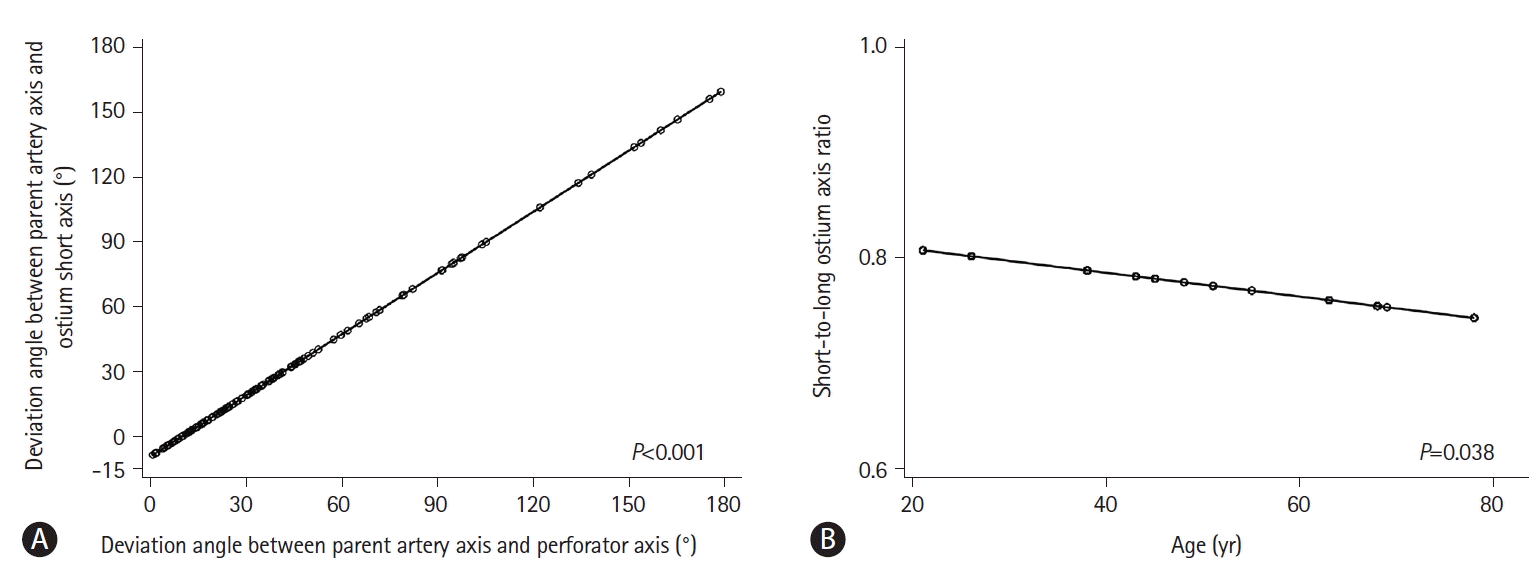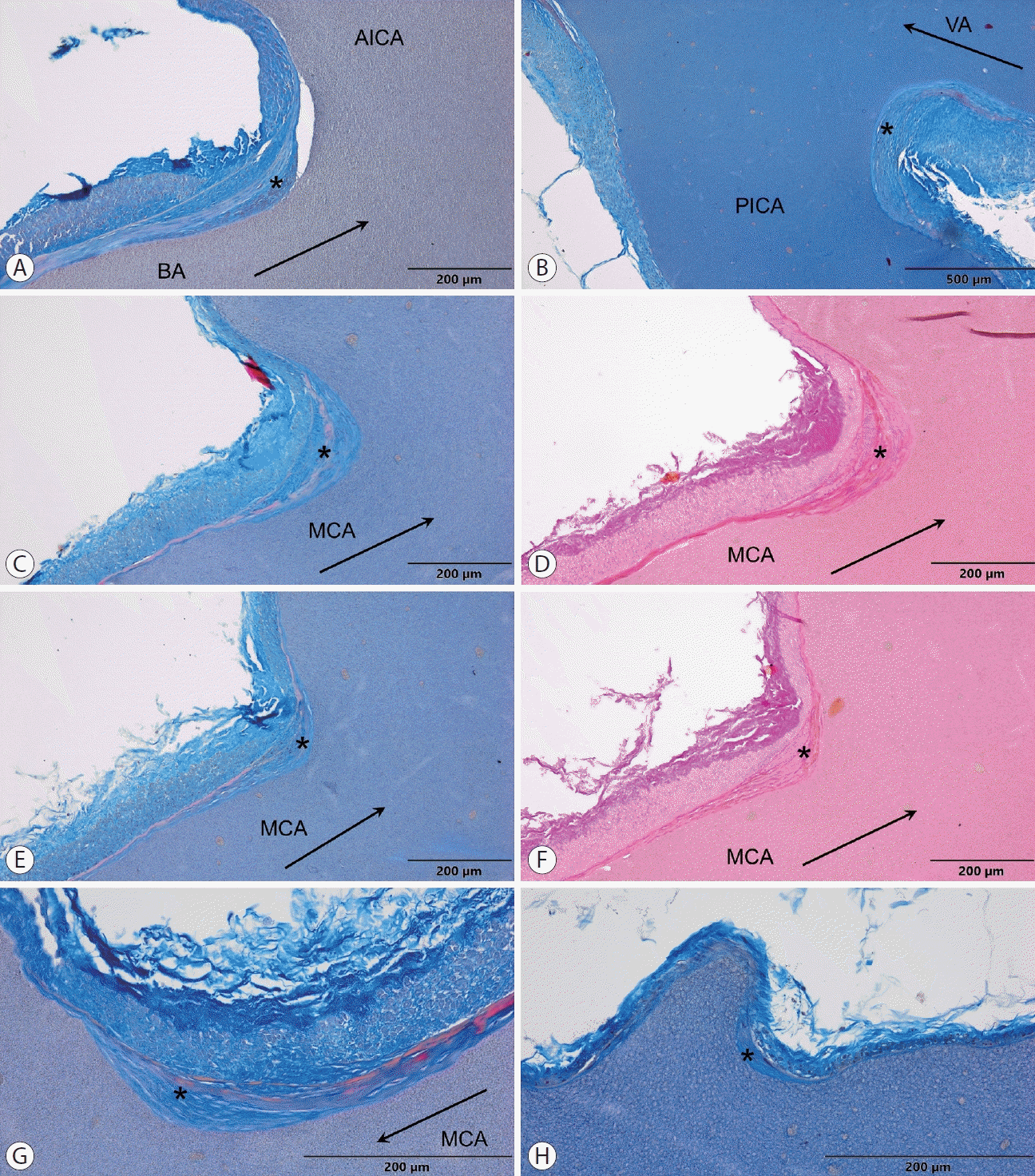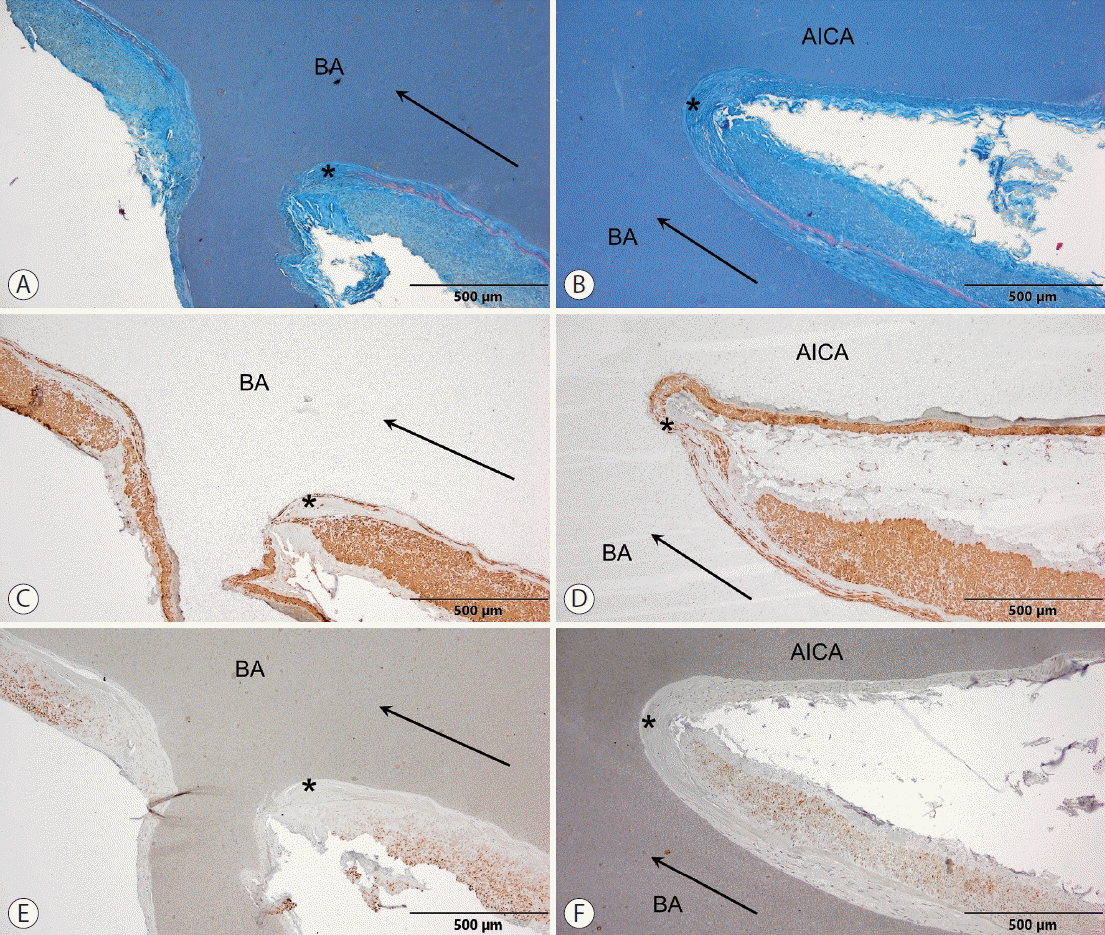2. Feigin VL, Norrving B, Mensah GA. Global burden of stroke. Circ Res. 2017; 120:439–448.

3. Krishnamurthi RV, Moran AE, Forouzanfar MH, Bennett DA, Mensah GA, Lawes CM, et al. The global burden of hemorrhagic stroke: a summary of findings from the GBD 2010 study. Glob Heart. 2014; 9:101–106.

4. Yang M, Yoo H, Kim SY, Kwon O, Nam MW, Pan KH, et al. Occupational risk factors for stroke: a comprehensive review. J Stroke. 2023; 25:327–337.

5. Prince M, Bryce R, Albanese E, Wimo A, Ribeiro W, Ferri CP. The global prevalence of dementia: a systematic review and metaanalysi. Alzheimers Dement. 2013; 9:63–75.e2.
6. Vogels V, Dammers R, van Bilsen M, Volovici V. Deep cerebral perforators: anatomical distribution and clinical symptoms: an overview. Stroke. 2021; 52:e660–e674.
7. Kwiatkowska M, Rzepliński R, Ciszek B. Anatomy of the pontine arteries and perforators of the basilar artery in humans. J Anat. 2023; 243:997–1006.

8. Kang DW, Kim DY, Kim J, Baik SH, Jung C, Singh N, et al. Emerging concept of intracranial arterial diseases: the role of high resolution vessel wall MRI. J Stroke. 2024; 26:26–40.

9. Brinjikji W, Murad MH, Lanzino G, Cloft HJ, Kallmes DF. Endovascular treatment of intracranial aneurysms with flow diverters: a meta-analysis. Stroke. 2013; 44:442–447.

10. Cannistraro RJ, Badi M, Eidelman BH, Dickson DW, Middlebrooks EH, Meschia JF. CNS small vessel disease: a clinical review. Neurology. 2019; 92:1146–1156.
11. Regenhardt RW, Das AS, Lo EH, Caplan LR. Advances in understanding the pathophysiology of lacunar stroke: a review. JAMA Neurol. 2018; 75:1273–1281.

12. Rzepliński R, Sługocki M, Tarka S, Tomaszewski M, Kucewicz M, Karczewski K, et al. Mechanism of spontaneous intracerebral hemorrhage formation: an anatomical specimens-based study. Stroke. 2022; 53:3474–3480.

13. Rhoton AL Jr. The supratentorial arteries. Neurosurgery. 2002; 51(4 Suppl):S53–S120.

14. Rzepliński R, Kostyra K, Skadorwa T, Sługocki M, Kostkiewicz B. Acute platelet response to aneurysmal subarachnoid hemorrhage depends on severity and distribution of bleeding: an observational cohort study. Neurosurg Rev. 2021; 44:2647–2658.

15. Rzepliński R, Sługocki M, Kwiatkowska M, Tarka S, Tomaszewski M, Kucewicz M, et al. Standard clinical computed tomography fails to precisely visualise presence, course and branching points of deep cerebral perforators. Folia Morphol (Warsz). 2023; 82:37–41.

16. Kim J, Mukherjee P. Static anatomic techniques. In: Naidich TP, Castillo M, Cha S, Smirniotopoulos JG. Imaging of the Brain. Philadelphia: Elsevier, 2013;3-22.
17. Salzman K, Osborn A, Linscott L. Arterial anatomy and strokes. In: Osborn A, Linscott L, Salzman K. Osborn’s Brain: Imaging, Pathology, and Anatomy. 3rd ed. Philadelphia: Elsevier, 2024; 145-180.
18. Tomaszewski M, Kucewicz M, Rzepliński R, Małachowski J, Ciszek B. Numerical aspects of modeling flow through the cerebral artery system with multiple small perforators. Biocybern Biomed Eng. 2024; 44:341–357.

19. Lasjaunias P, ter Brugge KG, Berenstein A. Embryological and anatomical introduction. In: Lasjaunias P, Brugge KG, Berenstein A. Surgical Neuroangiography. 2nd ed. Berlin: Springer, 2006;1-25.
20. Viale G. The rete mirabile of the cranial base: a millenary legend. Neurosurgery. 2006; 58:1198–1208.

21. Herz RC, Jonker M, Verheul HB, Hillen B, Versteeg DH, de Wildt DJ. Middle cerebral artery occlusion in Wistar and Fischer-344 rats: functional and morphological assessment of the model. J Cereb Blood Flow Metab. 1996; 16:296–302.

22. Federative International Programme for Anatomical Terminology. Terminologia neuroanatomica [Internet]. Halifax: Dalhousie University; 2017 [accessed July 22, 2024]. Available from:
https://fipat.library.dal.ca/TNA.
23. Rzepliński R, Tomaszewski M, Sługocki M, Karczewski K, Krajewski P, Skadorwa T, et al. Method of creating 3D models of small caliber cerebral arteries basing on anatomical specimens. J Biomech. 2021; 125:110590.

27. Rzepliński R, Sługocki M, Tomaszewski M, Kucewicz M, Krajewski P, Małachowski J, et al. Basilar tip fenestration giving rise to Percheron’s and mesencephalic arteries. Folia Morphol (Warsz). 2024; 83:451–454.

28. Murray CD. The physiological principle of minimum work applied to the angle of branching of arteries. J Gen Physiol. 1926; 9:835–841.

29. Murray CD. The physiological principle of minimum work: I. The vascular system and the cost of blood volume. Proc Natl Acad Sci U S A. 1926; 12:207–214.
30. Marinkovic S, Gibo H, Milisavljevic M, Cetkovic M. Anatomic and clinical correlations of the lenticulostriate arteries. Clin Anat. 2001; 14:190–195.

31. Weinberg PD. Haemodynamic wall shear stress, endothelial permeability and atherosclerosis—a triad of controversy. Front Bioeng Biotechnol. 2022; 10:836680.

32. Chiu JJ, Chien S. Effects of disturbed flow on vascular endothelium: pathophysiological basis and clinical perspectives. Physiol Rev. 2011; 91:327–387.

33. Malota Z, Glowacki J, Sadowski W, Kostur M. Numerical analysis of the impact of flow rate, heart rate, vessel geometry, and degree of stenosis on coronary hemodynamic indices. BMC Cardiovasc Disord. 2018; 18:132.

34. Kim MO, Li Y, Wei F, Wang J, O’Rourke MF, Adji A, et al. Normal cerebral vascular pulsations in humans: changes with age and implications for microvascular disease. J Hypertens. 2017; 35:2245–2256.
35. Wen B, Tian S, Cheng J, Li Y, Zhang H, Xue K, et al. Test-retest multisite reproducibility of neurovascular 4D flow MRI. J Magn Reson Imaging. 2019; 49:1543–1552.

36. Dong H, Ding H, Young K, Blaivas M, Christensen PJ, Wang MM. Advanced intimal hyperplasia without luminal narrowing of leptomeningeal arteries in CADASIL. Stroke. 2013; 44:1456–1458.

37. Yamada T, Shiraishi R, Taki K, Nakano S, Tokunaga O, Itoh T. Immunohistochemical and ultrastructural examination of smooth muscle cells in aortocoronary saphenous vein grafts. Angiology. 1997; 48:381–390.

38. Ko YS, Yeh HI, Haw M, Dupont E, Kaba R, Plenz G, et al. Differential expression of connexin43 and desmin defines two subpopulations of medial smooth muscle cells in the human internal mammary artery. Arterioscler Thromb Vasc Biol. 1999; 19:1669–1680.

39. Hainsworth AH, Markus HS, Schneider JA. Cerebral small vessel disease, hypertension, and vascular contributions to cognitive impairment and dementia. Hypertension. 2024; 81:75–86.

40. Pantoni L. Cerebral small vessel disease: from pathogenesis and clinical characteristics to therapeutic challenges. Lancet Neurol. 2010; 9:689–701.

41. van Veluw SJ, Arfanakis K, Schneider JA. Neuropathology of vascular brain health: insights from ex vivo magnetic resonance imaging–histopathology studies in cerebral small vessel disease. Stroke. 2022; 53:404–415.

42. Wang L, Liu Q, Yue D, Liu J, Fu Y. Cerebral amyloid angiopathy: an undeniable small vessel disease. J Stroke. 2024; 26:1–12.

43. Marinkovic ´ S, Todorovic ´ V, Drndarevic ´ N, Puškaš L, Lazic ´ D, Bojic ´ V, et al. Structure and immunohistochemistry of the human lenticulostriate arteries. Folia Morphol (Warsz). 2013; 72:210–216.

44. Caplan LR. Intracranial branch atheromatous disease: a neglected, understudied, and underused concept. Neurology. 1989; 39:1246–1250.
45. Caplan LR. Lacunar infarction and small vessel disease: pathology and pathophysiology. J Stroke. 2015; 17:2–6.

46. Fisher CM. Bilateral occlusion of basilar artery branches. J Neurol Neurosurg Psychiatry. 1977; 40:1182–1189.

47. Fisher CM, Caplan LR. Basilar artery branch occlusion: a cause of pontine infarction. Neurology. 1971; 21:900–905.
48. Kulcsár Z, Ernemann U, Wetzel SG, Bock A, Goericke S, Panagiotopoulos V, et al. High-profile flow diverter (silk) implantation in the basilar artery: efficacy in the treatment of aneurysms and the role of the perforators. Stroke. 2010; 41:1690–1696.
49. Masuo O, Terada T, Walker G, Tsuura M, Nakai K, Itakura T. Patency of perforating arteries after stent placement? A study using an in vivo experimental atherosclerosis-induced model. AJNR Am J Neuroradiol. 2005; 26:543–548.
50. Masuda J, Ogata J, Yutani C. Smooth muscle cell proliferation and localization of macrophages and T cells in the occlusive intracranial major arteries in moyamoya disease. Stroke. 1993; 24:1960–1967.

51. Masuo O, Terada T, Tsumoto T, Yamaga H, Nakai K, Itakura T. The study on the patency of the perforating arteries after stent placement in atherosclerosis induced rabbits. Interv Neuroradiol. 2004; 10(Suppl 1):57–62.

52. Singer JD, Willett JB. Examining the multilevel model’s error covariance structure. In: Singer JD, Willett JB. Applied Longitudinal Data Analysis: Modeling Change and Event Occurrence. New York: Oxford University Press;2003. p. 243–265.
53. De Silva TM, Faraci FM. Contributions of aging to cerebral small vessel disease. Annu Rev Physiol. 2020; 82:275–295.

54. Rajeev V, Chai YL, Poh L, Selvaraji S, Fann DY, Jo DG, et al. Chronic cerebral hypoperfusion: a critical feature in unravelling the etiology of vascular cognitive impairment. Acta Neuropathol Commun. 2023; 11:93.

55. Austin BP, Nair VA, Meier TB, Xu G, Rowley HA, Carlsson CM, et al. Effects of hypoperfusion in Alzheimer’s disease. J Alzheimers Dis. 2011; 26(Suppl 3):123–133.

56. De Vis JB, Peng SL, Chen X, Li Y, Liu P, Sur S, et al. Arterial-spin-labeling (ASL) perfusion MRI predicts cognitive function in elderly individuals: a 4-year longitudinal study. J Magn Reson Imaging. 2018; 48:449–458.

57. Mutsaerts HJMM, Mirza SS, Petr J, Thomas DL, Cash DM, Bocchetta M, et al. Cerebral perfusion changes in presymptomatic genetic frontotemporal dementia: a GENFI study. Brain. 2019; 142:1108–1120.
58. Wolters FJ, Zonneveld HI, Hofman A, van der Lugt A, Koudstaal PJ, Vernooij MW, et al. Cerebral perfusion and the risk of dementia: a population-based study. Circulation. 2017; 136:719–728.
59. Schnerr RS, Jansen JFA, Uludag K, Hofman PAM, Wildberger JE, van Oostenbrugge RJ, et al. Pulsatility of lenticulostriate arteries assessed by 7 tesla flow MRI—measurement, reproducibility, and applicability to aging effect. Front Physiol. 2017; 8:961.

60. Geurts LJ, Zwanenburg JJM, Klijn CJM, Luijten PR, Biessels GJ. Higher pulsatility in cerebral perforating arteries in patients with small vessel disease related stroke, a 7T MRI study. Stroke. 2019; 50:62–68.

61. Zhang Y, Chang P, Liu N, Jiang Y, Chu Y, Du W, et al. Correlation between lenticulostriate arteries and white matter microstructure changes in patients with cerebral small vessel disease. Front Neurosci. 2023; 17:1202538.

62. Livingston G, Sommerlad A, Orgeta V, Costafreda SG, Huntley J, Ames D, et al. Dementia prevention, intervention, and care. Lancet. 2017; 390:2673–2734.

63. Claassen JA, Jansen RW. Cholinergically mediated augmentation of cerebral perfusion in Alzheimer’s disease and related cognitive disorders: the cholinergic-vascular hypothesis. J Gerontol A Biol Sci Med Sci. 2006; 61:267–271.

64. Van Beek AH, Claassen JA. The cerebrovascular role of the cholinergic neural system in Alzheimer’s disease. Behav Brain Res. 2011; 221:537–542.

65. Mestre H, Tithof J, Du T, Song W, Peng W, Sweeney AM, et al. Flow of cerebrospinal fluid is driven by arterial pulsations and is reduced in hypertension. Nat Commun. 2018; 9:4878.

66. Lasjaunias P, Brugge KG, Berenstein A. Embryological and anatomical introduction. In: Surgical Neuroangiography. 2nd ed. Berlin, Heidelberg: Springer, 2006;1-25.
67. Hulley SB, Cummings SR, Newman TB. Designing cross-sectional and cohort studies. In: Hulley SB, Cummings SR, Browner WS, Grady DG, Newman TB. Designing Clinical Research. 4th ed. Philadelphia: Lippincott Williams & Wilkins, 2013;85-96.
68. Newman TB, Browner WS, Hulley SB. Enhancing causal inference in observational studies. In: Hulley SB, Cummings SR, Browner WS, Grady DG, Newman TB. Designing Clinical Research. 4th ed. Philadelphia: Lippincott Williams & Wilkins, 2013;117-136.
69. De Silva TM, Faraci FM. Microvascular dysfunction and cognitive impairment. Cell Mol Neurobiol. 2016; 36:241–258.

70. Iadecola C. The neurovascular unit coming of age: a journey through neurovascular coupling in health and disease. Neuron. 2017; 96:17–42.










 PDF
PDF Citation
Citation Print
Print



 XML Download
XML Download